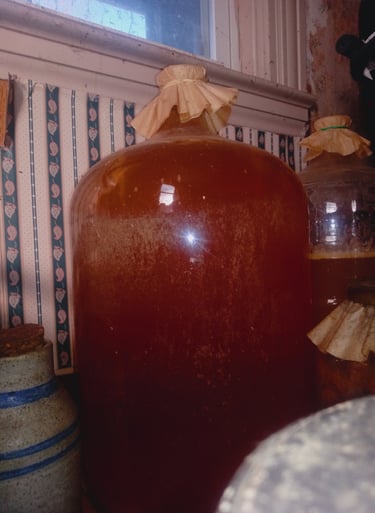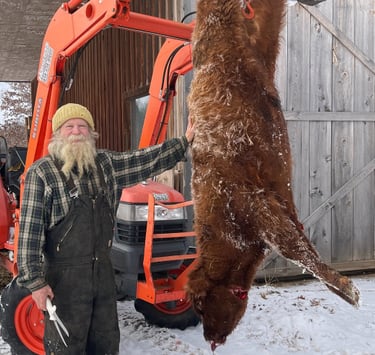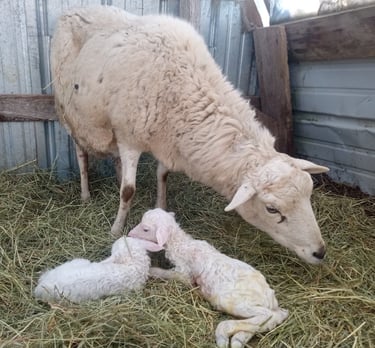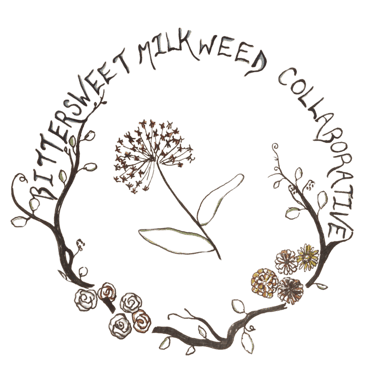December 2024
And In Renewing The Cycles, So They Renew Us
Kia-Beth Bennett
12/27/20246 min read
On the 15th, Jane had her piglets. Though one was fatally injured, they were born during the day, during a warm spell, and the remaining ten are doing amazing. Jane was more antsy than I would have liked, necessitating an afternoon beer-sesh for her, but once she fell asleep and the kids got to properly nurse, all was well. Her mother, Ladelaide, gave birth the 17th, quickly and with little notice. She’d endured a weird pregnancy, during which she was constantly hungry, restless, and then only had four piglets, one of whom was too underdeveloped to survive. Nevertheless, she’s now thriving. Having only a few kids to look after and getting daily motherwort tea seems to be a boon.
And in-between these activities are the usual winterizations of the farm, thawing of pipes, pounding down of applesauce and resting of compost piles. I’m treating the rams for liver fluke and getting them more protein, and I’ve moved back into my Winter hobby of sewing. It’s one of those tasks I feel no pressure to perfect; I simply find joy in the creation of art, or the mending of a seam. There’s much satisfaction to be found in repairing the fabric cover of my bike trailer - I get to see the lovely new flower patches covering embroidery floss stitches and think about how mending one’s personal items can be a reflection of a greater desire to mend relationships, ecosystems, and networks. As I weave the couch cushions back together, so I weave my life.
These are the sorts of warm, hefty thoughts that days spent indoors proliferate. Winter has its own set of struggles, but I'm trying to reconnect with what I love about The Work, and what brings me joy. My absolute favorite part? Circles.
I'll explain: this farming and community work is rooted in the reconnection of cycles and closed loop systems. Think about the basics of the hydrology cycle. Water comes from the sky, runs into the soil, is utilized by plants, transpires back to the sky - that sort of process. But the farm, as a complex being, is constantly cycling through multiple, overlapping, circular connections. Like how the apples from the neighbor's orchard that we pressed are now fermenting into vinegar that I'll feed to the sheep, who will then be slaughtered and given to said neighbors, and the compost from the meat scraps will be sprinkled in the orchard, producing abundant apples for another round of vinegar next year. Circles like that are, literally and figuratively, what keep me alive.
Given the chance, those connections keep rolling. I've been witness, the past few years, to the amazing cycles of pasture health improvements as a direct result of rotational grazing by our Highlanders. The herd has spent the last three years grazing in a pattern across the field, and as a result flowers are regrowing, seed production and dispersal is up, there’s a reduction in non native flora, an increase in field birds and pollinators equals more….and each aspect feeds the others. A field fertilized by cattle grows more seed-producing flowers, increasing the health of the pollinators, who create more seed, and seed-eating birds, who disperse the seeds to grow more flowers for the cows to consume and then fertilize the field with…It's an expanding system that once was everywhere. Depending on where you look, it's now being either renewed and destroyed.
But think about the abundance within that one system. The connections that breed health, relationships, food, carbon sequestration, beauty, color, joy. Think about how the bobolinks, meadowlarks and savannah sparrows migrate from this farm down to fields in Florida, Cuba and Mexico. How seeds they ate might be scattered in their manure on the flight down, spreading great blue lobelias and primroses. Or how, upon the death of one of those birds, the nutrients they consumed will turn back into soil. In this case, rotational grazing in the St Lawrence River Valley led to healthier soil that fed our cows, who then manured onto the ground, feeding fly larvae, who were then eaten by meadowlarks, who were eaten by a common black hawk in Mexico, whose own manure fertilized the soils there, growing plants with healthy seeds, who were eaten by bobolinks who, in three months, will begin their journey back to the farm.
That’s fucking amazing.
Look, I know that the bobolinks in the Yucatan Peninsula are not the chicken on your kitchen table. I know you might not feel the same connection. Maybe you live somewhere that bobolinks don’t, or perhaps they were extirpated, their cycles broken. Regardless - abundance, beauty, rhythms, webs, and circles are all around us, are in need of our attention, and are part of the healing process of our bodies, souls and world.
From this farm alone stems hundreds more stories of interconnectivity. I get high off these tales. I hope you can, too. I hope you can think about how the goldfinches at your bird feeder impact ecosystems hundreds of miles away, how sharing a pie with your neighbor can start a community network, how each of our actions can and usually do have impacts far beyond our immediate surroundings. I hope you can have faith that if a tiny bird in New York can alter pasture health in the Yucatan Peninsula, then surely, what you do can matter, too. Because I’m not the only one with stories to share. You exist within a unique and specific set of cycles, likely without even realizing it. You can talk about them, understand them, and learn how to heal broken loops. You can create your own cycles and your own stories. It’ll feel like a lot of work - it is. But trust me when I say that those cycles have always existed, have always been finding ways to come back when they’ve been destroyed, and once you become aware of them, you will feel supported in your work. You will feel loved. You will feel like whatever it was you wanted to do - yeah, it’s possible.
I would love to hear stories of the circles in your life. Please, share.
Much love,
Kia-Beth




Greetings All,
I can’t believe December has flown by so fast, but there’s been much going on. Early on this month, we got together with the Bartholomews to slaughter Fiddlehead and Jayce, two of our bulls. Folks always ask me if it’s hard to butcher those I raise, if I cry. Many people seem more comfortable with the distance that grocery-store food creates.
And I can understand that. I’ve been through so many iterations of eating all meat, eating the animals I raise, not eating them but eating animals from other local farms…At this stage, I don’t eat commercial meat, and I only eat animals I raised or I know how they were raised. It’s a connection I value, and one I am fortunate to be a part of. If I lived in a city, or didn’t have a reliable source of food, then I might do things differently.
Since I do have that opportunity to consume pastured, happy, cattle, however, I’m going to respect them and do it well. Two weeks prior to the slaughter date, I informed Fiddlehead and Jayce we’d be killing them for food, and I discussed the details of how we’d do it. I do this with every animal, whether they’re being slaughtered or moving to a new farm - I tell them what’s going to happen. Brian and I spent a week preparing the barn stall to hold them, and the day before the killing, the boys calmly walked into the barn on their own. There were, quite literally, no issues. No mooing, no running, no other cows crowding the fresh hay and the open gate. The same thing happened when they were loaded onto the trailer and driven to the Bartholomew’s house. No muss, no fuss. Jeremy killed them smoothly and quickly, then he, Brian and I skinned and eviscerated them, using the peculiar method of blowing up the skin to ease the process. (I learned that from a two-line anecdote in The Dirty Life.) And it was beautiful. I slid the organs and tallow into bags for further cleaning, and we hung both bodies from the ceiling of Jeremy’s barn.
On December 27, my dear friend Emily arrived from Albany, armed with freezer paper, sharpened knives and hella enthusiasm. Emily learned professional butchery in the Adirondacks and returns to the North Country to teach and assist with our large-animal projects. On the 28 and 29, everyone gathered in the 40 degree barn to cut filet mignon, ground beef, sandwich steaks and more, all while listening to Brian’s favorite 60s tunes and stuffing ourselves with banana bread.
I don’t know that I’ll ever participate in a greater moment of love than that.


